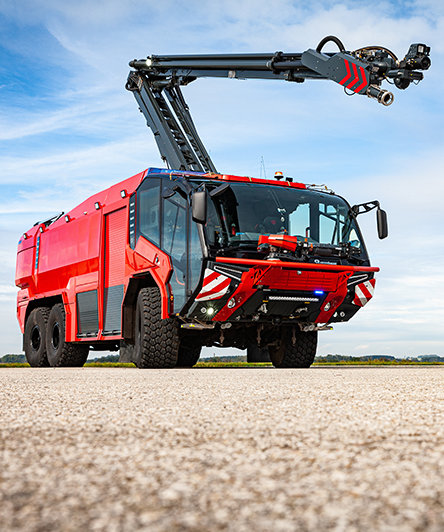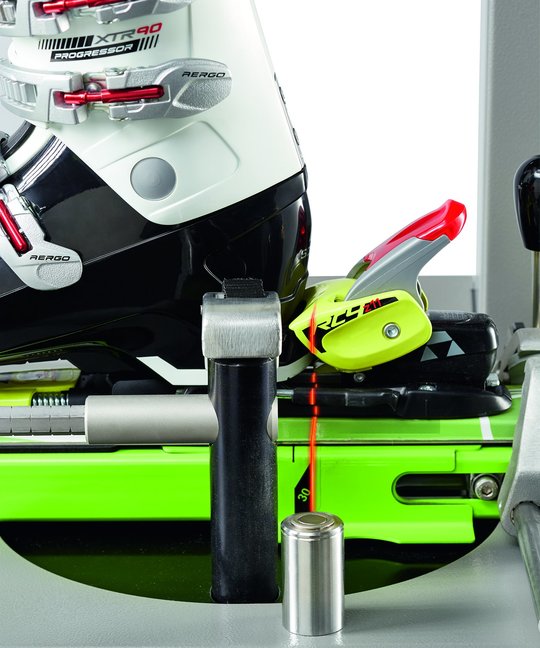Challenge
High tech door for cat and dog
Producing animal doors is no great challenge. But making animal doors for passive houses is. Petwalk is the first company on the market to develop automated animal doors for passive houses in cooperation with Ginzinger electronic systems. Thermally insulating, burglar-proof and fully networked.
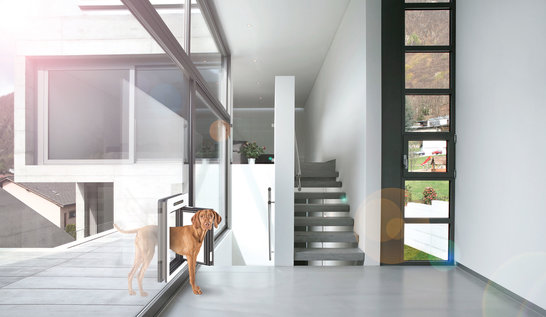
A pet door makes life easier for cat and dog owners. It becomes truly intelligent when the pets can enter and leave at any time via access recognition and the door even promises additional burglary protection. Petwalk Solutions took on this challenge together with Ginzinger electronic systems.
LET THE PET WALK

Petwalk Solutions GmbH & Co KG
Petwalk Solutions from Lower Austria is a manufacturer of premium pet entrance doors. The patented and award-winning petWALK doors are absolutely airtight, thermally insulated and burglar-proof pet entrance solutions. They are flexible in design and function to meet the needs of pets and owners, and are exported to 28 countries around the world.
For the realization of the complex technology behind the pet door, PetWALK relied, among other things, on state-of-the-art electronics from Ginzinger electronic systems to realize the extensive requirements for the high-tech pet door.
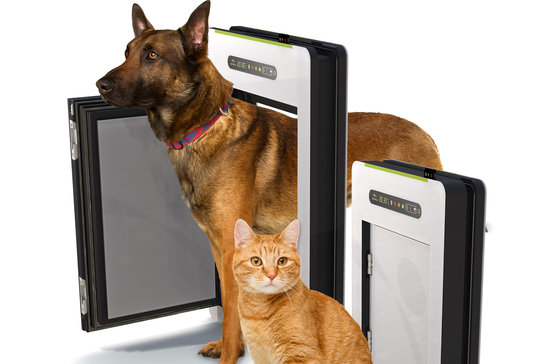
High requirements
The development of the complete software and hardware had to be implemented. What was originally intended only for cats, developed in the second step into a "door for animals", because in the meantime about half of all four-legged users are dogs.
The specifications for the pet door were extensive: In addition to suitability for passive houses, there were also numerous requirements that were to make the pet door "intelligent": Burglar resistance according to resistance class II, including an integrated alarm system, was an important point. Also the possibility of the admission recognition, both for animals with implanted chip, and for not chipped, were on the "To Do" list. For example, it should only be possible for pets to enter and leave the house at any time or at fixed times by means of a "house key".
High technical standards
Safety & Functionality
Basically, a petWALK pet door had to meet the same technical standards and customer requirements as a high-quality pet door. The top priority during the entire project was, of course, the safety of the pets.
Ginzinger electronic systems started with the software and hardware development of a 32bit microcontroller board to control the pet door and a second control and display board with LED and 7-segment display, including a remote control. The power supply management was also handled by the control board. With the help of charging electronics, the integrated battery can be operated and the animal door works even if the power in the house fails.

Challenge access detection
Probably the biggest challenge for the development team of Ginzinger electronic systems was the access recognition via RFID. This system consists of a transponder (in this case the implanted chip of the pet) and a reader for reading (RFID antenna). Since RFID was only developed for close range, i.e. for a distance of only one to five centimeters, the greatest difficulty was to increase the distance for the access system. This is because as soon as there is an obstacle between the antenna and the transponder (for example, the muzzle of larger dogs), recognition no longer works.
Various other solutions were then tested: With an external RFID antenna placed in front of the animal door, an attempt was made to reliably read the RFID tag by rubbing the animal's neck against the antenna in order to open the animal door. Another variant was to install a kind of "portal" in front of the animal door, which the animal must first pass through to gain access. However, all this was not a satisfactory solution, as everything had to be completely integrated into the door. Many tests and trials followed until the Ginzinger software team achieved a breakthrough for the access system:
With the help of complex signal processing algorithms, the developers were able to improve the RFID control and also make the system itself less noisy. Finally, they succeeded in completely integrating the antenna in the door leaf in accordance with the customer's wishes. Since not only animals with implants should be able to go in and out conveniently via RFID, another issue was the topic of "motion detectors" for non-chipped pets. By means of a tag on the collar as a "door opener" (only) the own animals should be recognized by the door and let in and out. This task also turned out to be more difficult than initially assumed.
The first approach was to use a standard motion detector. However, every higher-quality detector has a so-called "animal suppression" as standard. This made it impossible to use. Subsequent tests with infrared distance sensors were also unsatisfactory. They reacted too sensitively to wind, or leaves blowing past, and unreliably in rain. Most importantly, black dogs and cats were not detected at all. Radar and ultrasonic sensors also did not work in bad weather and were also too expensive.
Clever combined
PIR and capacitive sensors
Using PIR (passive infrared) sensors, the range was too high at up to 5m. This would cause the door to open too quickly. Finally, capacitive motion sensors were tested. These are highly sensitive and caused several false triggers, but in the "right" close range of about 60-80cm they worked. The combination of PIR and capacitive sensors proved to be the best solution. False triggers by the capacitive sensor are suppressed by the PIR sensor.
In terms of burglar resistance, the pet door currently operates with a four-regulation mechanism, similar to that used in burglar-proof windows in new homes. Initial attempts with doors suspended by springs, which do not injure the animal in case of entrapment, were useless. Again, functionality was not given in bad weather and locking like a safe was not possible because very powerful motors had to be used, which in turn are very expensive. In total, the development and technical implementation took over three years.
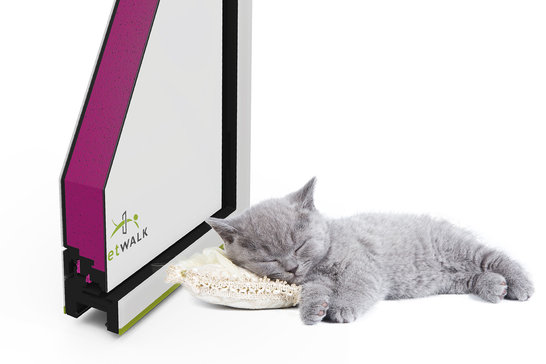
Next Generation: "Animal Door 4.0
The next generation of animal doors is already in the starting blocks. With it, more flexible positioning can be achieved by means of an independent RFID module to further improve malfunctions in critical installation situations. With new "Time of Flight" sensors, the range can now be flexibly adjusted via the software. Of course, the buzzword "IoT" in combination with the animal door should not be missing. As of now, this is linked to the Internet and enables further functions: Due to international sales, there are increased requirements for service and maintenance, which is now also made possible remotely. Data collection via the cloud is also possible.
The petWALK door pet is the world's first fully connected high-end pet door that offers control via mobile app, web browser or smart home devices. Using Amazon's "Alexa" or Google "Home," a voice command will soon be able to send the pet out of the house. On the road, the owner can be kept up to date on current events and learn via timeline what is going on at home during the day. The connection to WIFI or nest cameras, which enables a new type of animal recognition and as an intelligent video interface the observation of the animal's entrance, will also be implemented.
After we had already realized the initial version of our animal door with the support of Ginzinger electronic systems, this partnership was a "laid on thing" when it came to the expansion to the networking possibilities of the Internet-of-Things. Especially due to the stable foundation of the GELin Linux system we were able to master this challenge.
The new applications of the "TierTüre 4.0" could be realized thanks to a stable and completely integrated embedded solution from Ginzinger electronic systems with an ARM hardware architecture from NXP (in this case i.MX28) and the embedded Linux platform GELin from Ginzinger. Where microcontrollers including software would quickly reach their limits in terms of performance, the embedded solution with Linux operating system for petWALK's application offers a wide range of technical possibilities.
An additional area of application and at the same time proof of the technical versatility of embedded Linux will be the future cooperation with parcel service providers. For example, the premium pet door will soon be able to be used as a parcel drop-off station. Even if the homeowner is not at home, authorized parcel services can open the pet door via barcode scan to drop off your parcel. Or the homeowner can conveniently open the door via smartphone while on the move. By means of a quick message, he receives the information on his mobile device that the parcel service is at the door. Thus, the embedded Linux solution from Ginzinger electronic systems proves to be a future-proof, stable platform for further innovative ideas from petWALK.

Terms and questions about the project
What does burglar resistance according to resistance class II mean?
This resistance class "RC 2 N" provides basic protection against attempted burglary with simple tools such as screwdrivers, pliers or wedges.
What is RFID?
RFID (radio frequency identification) using electromagnetic waves refers to a technology for transmitter-receiver systems for the automatic and contactless identification and localization of objects and living beings using radio waves. An RFID system consists of a transponder (also known colloquially as a radio tag), which is located on or in the object or living being and contains an identifying code, and a reader for reading this identification.
What is a PIR sensor?
A PIR sensor - also called a pyroelectric sensor - is a semiconductor sensor that is used to detect temperature changes. The abbreviation stands for Pyroelectric Infrared Sensor or Passive Infrared Sensor.

